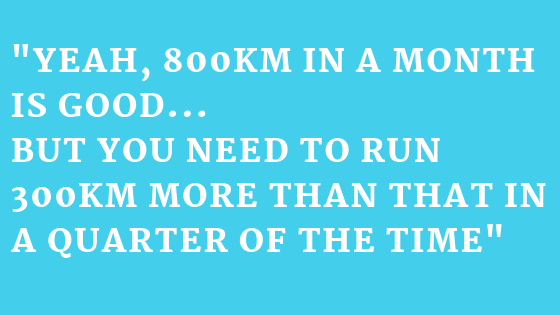What is the Monthly Mileage?
This is a series which gives you an insight into my preparation for my world record running attempt in May 2019.
It includes an overview of my running and nutrition stats for the month.
Plus, there are tips that will help you achieve your goals.
If you’d like a quicker and easier way to achieve your goals, rather than reading and having to understand lots of advice, find out more about the coaching services I offer, by clicking the button below.
In December, my training volume increased significantly.
And so this month’s tips are all about how to increase your training distance, whilst staying injury-free.
But first, the below video gives an overview of my key stats for the entire of 2018, from Strava’s year in review.
My running highlights from 2018, including total distance run and climbed
What Were My Running Highlights for December?
In December I ran more than 800km (500 miles).
Which was my biggest ever month of running!
But as I was proudly stating that to my wife, she pointed out that I’ll have to run 300 miles more than that in about a quarter of the time in May 2019…
... If I am to beat the world record for running from Land’s End to John o’ Groats…
… So that brought me crashing firmly back down to earth!
Even though I ran 800km (500 miles) in December, Catherine brought me firmly down to earth by reminding me of how much further I have to run in May 2019!
Anyway, I kicked off December incredibly well, with my biggest ever week of running - 286km (178 miles)!
And there was another huge week of 258km (160 miles).
Both is which even included a rest day!
And despite these two huge weeks, I also had more rest days than usual.
Which was great as I managed to spend a lot of time with family over the festive period.
Here are some of my key running stats for December:
806km (507 miles) - Total distance ran
26km (16 miles) - Average distance ran per day
50km (31 miles) - Longest individual run
67 hours, 39 minutes - Total time spent running
6,850 metres (22,800 feet) - Total elevation. The equivalent of Mount Aconcagua in Argentina - The highest mountain in the Western and Southern Hemispheres
December was my biggest ever month of running… Although if I hope to be on track for my world-record attempt in May 2019, I’l have to have some much bigger months!
You can track my training by following me on Facebook, Twitter, Instagram and Strava.
How Much Crap Did I Eat in December?
As with everyone, the biggest challenge in December was to control myself when faced with the constant partying and excess food which was on offer practically every day.
And it didn’t start off well.
The first hurdle was our annual, weekend family trip to Bruges.
This is the third year in a row we’ve been and it’s a battle to fight the temptation of beer, chips, chocolate and waffles.
And I lost every single battle whilst I was there...
Our family trip to Bruges meant that we had some great time together… But also meant that I over-indulged. But Rosie tried to support me and makes me feel better by indulging in hot chocolate with her grandad too!
Lottie also wanted to help me feel better. Here she is tucking into peppercorn sauce and a steak!
It wasn’t long before I lost the next battle - the annual wine and cheese party that Catcherine and I host.
Technically, cheese is perfectly acceptable on my high fat, low carb diet.
Although maybe not in the quantities that I ate that night!
I managed to tuck away 6,000 calories that day, which was the highest for the month.
Even I was quite impressed by that!
Although it doesn’t even come close to my highest day of calories since I started tracking my food intake...
Around 9,000 a day for 9 days!
When we were at an all-inclusive holiday in Cyprus in November 2017!
I did have a couple of successes where I managed to avoid drinking at some social events...
... Before giving in and completely losing willpower over the Christmas period.
Like many others I ended up eating my own body weight in chocolate, cheese and Christmas dessert - my mother-in-law’s delightful bread and butter pudding!
We celebrated a mini family Christmas with wine, cheese, meat and The Snowman as a special treat
A final, over-indulgent trip to Dublin to celebrate Catherine’s birthday finished the year in style.
We ended 2018 by celebrating Catherine’s birthday in Dublin… I ended up eating the entire plate of birthday chocolates from our hotel!
And now it’s time to get serious in the 5 months building up to my world-record attempt at the end of May 2019.
My key food stats for December were:
120,000 total calories eaten - Averaging 3,850 per day
128,000 total calories burnt - Averaging 4,100 per day
6,000 calories - Most consumed in a single day - At the annual Williams wine and cheese night
6,200 calories - Most burnt in a single day - On a day where I ran 31 miles and even managed to get in a bit of yoga
Even Elf-on-the-shelf tried to help me stop over-eating at Christmas by tucking into our mince pies…
December’s Top Tips - 3 Ways to Increase Your Distance AND Stay Injury Free
Increasing your distance is one of the basic elements when training for endurance events.
And there are both physiological and psychological benefits from doing this .
But if you do it the wrong way it can also lead to injury and burnout.
So here are 3 methods that I’ve used which allowed me to run 800km (500 miles) in December 2018.
I am at the extreme end of the scale for distance running...
... But these tips will apply no matter what your level is and what you are aiming for.
1) Increase Gradually
One of the most important pieces of advice is that you should not increase your training volume too quickly.
But what does ‘too quickly’ actually mean?
A simple rule you could follow is don’t increase by more than 10%.
For example, if you ran a total of 50k last week, you wouldn’t run more than 55k this week.
Although this is a straightforward rule, I don’t believe in blindly following the 10% principle.
As with any rule, there are lots of times when it should be broken. For example
If you’re at the very start of a training plan and your mileage is low - Increasing by more than 10% is probably perfectly safe. Especially if you are an experienced athlete
If you’re an experienced athlete, you can probably increase by more than 10% safely - For example, if your last long run was 30k, you could easily go up to 35k
Including recovery weeks - In every 3rd or 4th week, it’s a good idea to lower your training volume, rather than to keep increasing it
There are people who argue that you need to think about other things than just the 10% rule (which I agree with).
But the main idea with the 10% rule is very good...
“Don’t increase your mileage too much, too quickly.”
2) Follow the 80/ 20 Rule
This is another simple, but effective way of staying injury free, whilst increasing mileage.
This rule states that most of your running (around 80%) should be done at a low intensity.
And the other 20% should be done at very high intensity.
And it’s claimed that most elite athletes follow this principle in training.
What counts as ‘easy’ is completely dependant on the individual.
But it is almost certainly slower than what you are currently doing in your training runs.
And that’s because most people are stuck in the ‘moderate-intensity rut’ - where you’re training at an intensity which neither helps you recover, build endurance or build speed.
“The overwhelming majority of adults who come to our camps is that they tend to do their daily runs too hard.”
This article gives some guidance on how to calculate your thresholds for high and low intensity workouts.
And how to apply them to your training routines.
3) Start Doing Double Days
One of the most effective methods for increasing your overall distance is to train twice in one day.
There are lots of world-class coaches and runners who swear by this method.
Camille Herron, who recently broke the women’s 100 mile and 24 hour world records (in the same race!), uses double days.
Camille stated that she never ran longer than 22 miles in an individual run, whilst training for the 24 hour event.
But she runs twice every day to get in her high mileage weeks.
She argues that doing two long runs is better than doing one extremely long run.
And she’s got a Master of Science in Exercise and Sport Science. So she knows what she’s talking about!
“I run twice a day, every day, and put in week after week of 120-plus miles”
World-famous coach Greg McMillan has given some specific advice on how to start running twice in a day.
He even argues that it’s a good method for new runners to stay injury-free.
Personally, double-days have been one of the best ways that I’ve increased my mileage.
In some weeks in December, I ran 4 double-days which includes 30k (19 miles) in the morning and 20k (12 miles) in the evening.
I include them as part of my daily commute, which is a great time saver.
But I am at the extreme end of the scale for using double days.
If you want to start doing two sessions a day, you should start slowly and with a small distance.
This article gives some practical advice on how to introduce double days, including
Splitting up a normal distance run over 2 sessions
Adding cross-training on the same day - Especially if you’re injury-prone
Don’t run double on a long day (when you’re starting out). If you’re more experienced, doing a second easy run on days when you do a long run is an excellent way of increasing distance and adapting your body!
How Do You Increase Your Distances in Training?
Let me know in the comments at the bottom of this blog, on the Contact Page or on social media below.
What’s Coming Up in January?
My training now begins to get really serious in preparation for my world record attempt in May 2019!
The main focus for the month will be on my first big training weekend.
During that weekend, I’ll be running 64k (40 miles) on the Friday, 80k (50 miles) on the Saturday, 80k (50 miles) on the Sunday and 50k (31 miles) on the Monday!
For a total of 274k (171 miles) in 4 days!
But the most important part of that weekend will be that my crew will be joining me for part of it.
And we’ll be practising as if it’s the real world record attempt!
So if you see someone running in circles round Richmond Park, with three bikes following, be sure to say hello!
You can follow my training on social media and on Strava.
Save Time, Money and Effort by Claiming Your Free Training Plan Template
Join hundreds of other athletes who get amazing benefits, simply by providing your email.
A FREE training plan template - Which will save you time, money and effort when creating your plans
The best training and racing advice from across the web - I send these articles out every month, exclusively, to email subscribers
Early access to exclusive offers and deals - I send out the best discounts and offers to email subscribers first, before anyone else
What Did You Think Of This Article?
I would love to get your honest feedback about what you think about the articles on JamesRunsFar.com.
I can use your feedback to write blogs that what will help you achieve your goals.
Simply tell me what you think by filling in this 1 minute survey.
What Should You Read Next?
Achieve your goals quicker and easier, by hiring me as your coach
Improve your performances by using my Personally Tried, Tested and Recommended Kit











